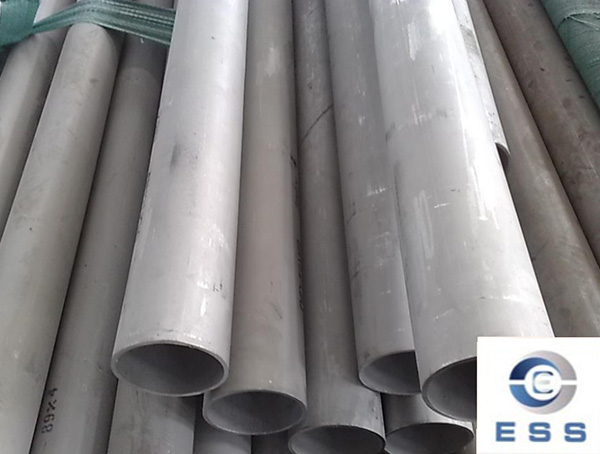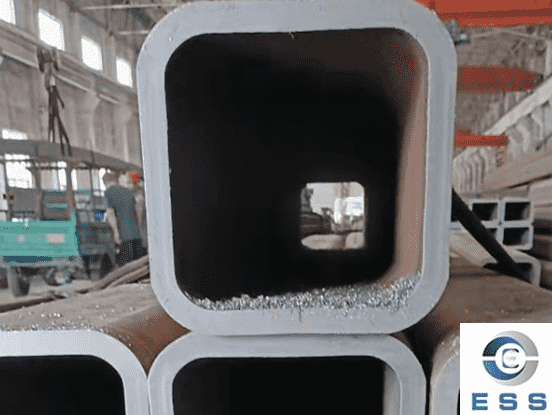Heat treatment defects and prevention of
seamless steel pipes
1. Definition: According to different purposes, metal materials are heated to a suitable temperature and held, and then cooled in different ways to change the metallographic structure of the metal materials and obtain the required microstructure properties. This process is usually called heat treatment of metal materials.
The heat treatment of metal materials is divided into:
①overall heat treatment
②surface heat treatment
③chemical heat treatment
Heat treatment defects of steel tubes mainly include: unqualified microstructure and properties of steel tubes, excessive size, surface cracks, scratches, severe oxidation, deC, overheating or overfiring, etc.

2. Steel tube heat treatment and process characteristics:
① Heat treatment:
a. Heating: Heating below Ac1 is mainly to stabilize the structure of steel and eliminate internal stress. Heating above Ac3 is mainly for austenitizing steel.
b. Insulation: The purpose is to homogenize the heating temperature of the steel pipe so as to obtain a reasonable heating structure.
c. Cooling: The cooling process is the key process of steel pipe heat treatment, which determines the metallographic structure and mechanical properties of steel pipe after cooling. Commonly used cooling methods are: furnace cooling, air cooling, oil cooling, water cooling, etc.
②Steel pipe normalizing: it refers to the process of heating the
seamless steel pipe to the temperature above austenitizing, holding it for a period of time, and then cooling it gently and evenly in the air, so as to obtain the stable organization
a. Main purpose: refine the grain of steel, homogenize the internal structure, change the residual stress state, and improve the comprehensive performance of steel pipe.
b. Main functions: reduce or eliminate the banded structure and mixed crystal formed in the deformation process of steel pipe; The net carbides in hypereutectoid steel are eliminated to facilitate spheroidizing annealing. Used as pretreatment of medium C steel and alloy structural steel before quenching, to refine the grain, make the structure uniform, reduce the steel pipe defects caused by quenching process; For low C steel and low alloy steel instead of annealing, in order to improve the cutting performance of steel pipe, it can be used as the final heat treatment of ordinary steel pipe with low requirements.
③Steel tube annealing: the steel tube is heated to a certain temperature higher or lower than the critical (Ac3 or Ac1). After holding for a period of time, the steel tube is cooled slowly to obtain the approximate equilibrium microstructure process, which is divided into recrystallization annealing, complete annealing, isothermal degradation, spheroidization annealing and stress reduction annealing. Generally, high C, low alloy and alloy steel pipes need to be annealed to reduce their hardness and strength, improve plasticity, eliminate internal stress and uneven structure, and refine the crystalline structure, so as to facilitate the machining of steel pipes and lay the foundation for the final heat treatment of steel pipes.
④Steel pipe tempering: the steel is heated to a certain temperature below Ac1, held for a period of time, and then the steel pipe is cooled in a certain way to get a more stable state organization process.
a. Main purpose: To improve the plasticity and toughness of the steel pipe, make the steel pipe obtain good comprehensive mechanical properties, reduce or eliminate the residual internal stress caused by the steel pipe during quenching, and stabilize the size of the steel pipe, so that the structure of the steel pipe does not change during use.
b. Air cooling is generally used after steel pipe tempering: in order to prevent the steel pipe from re-producing internal stress, it should be cooled slowly. For steel pipes with high temperature tempering brittleness, rapid cooling should be used after tempering, such as oil cooling.
c. Steel pipe tempering is generally divided into:
Low temperature tempering 150 ~ 250℃
Medium temperature tempering 350 ~ 500℃
High temperature tempering 500 ~ 650℃
⑤ Steel pipe quenching: the steel pipe is heated to Ac3 above 30 ~ 50℃, after holding for a period of time, the steel pipe is rapidly cooled to get M and B structure process.
a. M generally has high hardness and brittleness, which is the product of A's rapid cooling.
b. In addition to M and B, there is A small amount of A residue in the steel pipe after quenching, which are unstable tissues.
c. After steel pipe quenching, its internal thermal stress and structural stress, generally can be eliminated and improved by tempering, tempering (Q+T) can make the comprehensive performance of steel has been greatly improved.
⑥ Solution treatment: the essence is the quenching process of steel pipe, but the temperature of solution treatment is higher. Solution treatment is mainly used for A stainless steel pipe, its purpose is to reduce the hardness and strength of the steel pipe, improve the plasticity and toughness of the steel pipe, and improve the corrosion resistance and comprehensive performance of the finished steel pipe, to meet the standard or user requirements.
3. Defects in heat treatment of steel tubes and their prevention
① Unqualified steel tube structure and performance: three elements caused by improper heat treatment (T, T, cooling mode)
a. Weihua structure: A kind of structure in which the coarse grain A formed in steel under high temperature heating conditions forms flake F and distributes on P when it is cooled. It is A kind of superheated structure, which has A bad influence on the comprehensive properties of steel pipe, especially the strength of steel at room temperature decreases and the brittleness increases.
b. The mild W structure can be eliminated by normalizing at appropriate temperature, while the severe W structure can be eliminated by secondary normalizing. The first normalizing temperature is higher, the second normalizing temperature is lower, and the grain is refined.
c. The F-C equilibrium diagram is an important basis for formulating the heating temperature of steel tubes during heat treatment, and it is also the basis for studying the composition, microstructure and properties of F-C composites under equilibrium state. The TTT diagram of supercooled A and the CCT diagram of supercooled A are important basis for formulating the cooling temperature of heat treatment.
② Unqualified steel pipe size: outer diameter, ellipticity, bending out of tolerance.
a. The change of outer diameter of steel pipe often occurs in quenching process, and the outer diameter of steel pipe increases due to the change of volume (caused by the change of structure). Sizing process is often added after tempering process.
b. Variation of steel pipe ellipticity: the end of steel pipe is mainly large-diameter thin-walled pipe.
c. Steel pipe bending: caused by uneven heating and cooling of steel pipes, it can be solved by straightening. For steel pipes with special requirements, warm straightening process (about 550℃) should be adopted.
③ Steel pipe surface crack: because the heating speed or cooling speed is too fast, the thermal stress is too large. In order to reduce the heat treatment crack of steel pipe, on the one hand, the heating system and cooling system of steel pipe should be formulated according to the steel type, and suitable quenching medium should be selected. On the one hand, the quenched steel pipe should be tempered or annealed as soon as possible to eliminate its stress.
④ Steel pipe surface abrasion or hard injury: steel pipe and workpiece, tool and roller table between the relative sliding.
⑤The steel pipe produces oxidation, dec, overheating or overburning. T↑, T↑.
⑥ Protection of gas heat treatment of steel pipe surface oxidation: heating furnace sealing is not good, the furnace into the air. The composition of furnace gas is unstable.
▽ The quality control of the heating process of the billet (steel pipe) must be strengthened.













 Eastern Steel Manufacturing Co.,Ltd not only improve product production and sales services, but also provide additional value-added services. As long as you need, we can complete your specific needs together.
Eastern Steel Manufacturing Co.,Ltd not only improve product production and sales services, but also provide additional value-added services. As long as you need, we can complete your specific needs together.










